Our interview with Louis Turmel, the CEO and founder of Beenote will provide you with interesting solutions and valuable advice to optimize your meetings forever. You’ll learn how the Beenote teams use their own meeting management software!
- Why a meeting management solution?
- What are meetings for Beenote?
- Why the bee at Beenote? What does it relate to meetings?
- What types of meetings do you hold?
- How does Beenote manage these teams in the software?
- How does the meeting process work at Beenote?
- Schedule Management
- Pre-work: The Agenda
- D-Day: The 1st meeting with Beenote
- Before we run the meeting
- We start the scheduled meeting
- To conclude: The minutes of meetings
- Holding the next meeting
- Statistics for efficient meetings
Why a meeting management solution?
Where did this idea come from in the first place?
A few years ago, I went to so many meetings that I thought it was a waste of time. Indeed, a meeting confirmed my thoughts. I’ll tell you about it.
I was invited to attend a product launch meeting where I was the main topic of the meeting. So I was prepared: my speech was ready, I knew the purpose of the meeting and above all, I knew why I was there! However, for my neighbor, it was a completely different reality. Let me explain.
When he arrived, he asked me if I knew why I was there. Innocently, I told him no, I did not know why I attended this meeting and, to my surprise…him either!! He even told me that to make sure he didn’t miss anything, he invited his colleagues to also join the meeting, just in case!
At that point, I realized that people were not involved, did not know why they were meeting and were unprepared. Of course, the project did not achieve its objectives. This is a common case, which happens so often in the organization.

Deep inside, I realized that we needed to help companies better manage their meetings, to achieve operational efficiency. At first, I thought that Voxlog could be the ideal tool to help me prepare and hold more efficient meetings. However, Voxlog is a recording tool with added notes and in this case, I needed a note tool that could be used as a recording tool to improve our statements.
Beenote was born in these early days to be what we know today. A meeting management solution that provides a pre-established agenda and minutes structure and that provides an audio recording in addition to a variety of other features.
What are meetings for Beenote?
We like to hate meetings, but they are there to stay because they are important, even essential to the progress of projects, to make decisions, or to share information. The important thing about meetings is not quantity, but quality. If they are better planned in advance, they will be more productive when they are held and people will spend less time in the post-meeting to complete the minutes.
Add up to 14 hours a month to your calendar using a meeting management solution like Beenote.

Why the bee at Beenote? What does it relate to meetings?
As you may have noticed, the bee is Beenote’s emblem. It’s no coincidence, you know. The bee is an insect that functions in a group, with a very precise hierarchical level with established tasks and roles.
Each of the bees is useful, each in its own individuality, allows the group to move forward, build the hive, collect the pollen, and finish, to reap the fruit of their effort: honey. We can therefore easily draw parallels between the workplace and corporate meetings.
What types of meetings do you hold?
At Beenote, the types of meetings have evolved with the product because we are a startup. Initially, we held brainstorming meetings to develop the product, brainstorm ideas, share ideas and test it with targeted groups.
Subsequently, there are project management meetings: problem-solving, validation, solution proposals, and deliverable meetings.
Now that the product is mature, we hold weekly information meetings between different departments to inform others on the progress of our respective tasks, a little in the scrum style.
We also have daily meetings to discuss, exchange, and make decisions on the next steps.
How does Beenote manage these teams in the software?
We use several organizations created in Beenote to document meetings according to our department. This is ideal for companies that have multiple clients so that the organizations in Beenote can correspond to each client.
We have chosen to create organizations for our customer demos, software tests, tutorials from our online help site, and our core team.
Within an organization, it is possible to create multiple teams. Beenote uses them to structure the department further.
In addition, we organize our teams’ documentation with folders in order to separate different meeting objectives.
In the image below, we are in the Comnet Technology Inc. organization, the Comnet team where we have our weekly meetings. We have folders for our information-sharing meetings(Comnet) then one for discussing Voxlog and another for the Beenote application only.
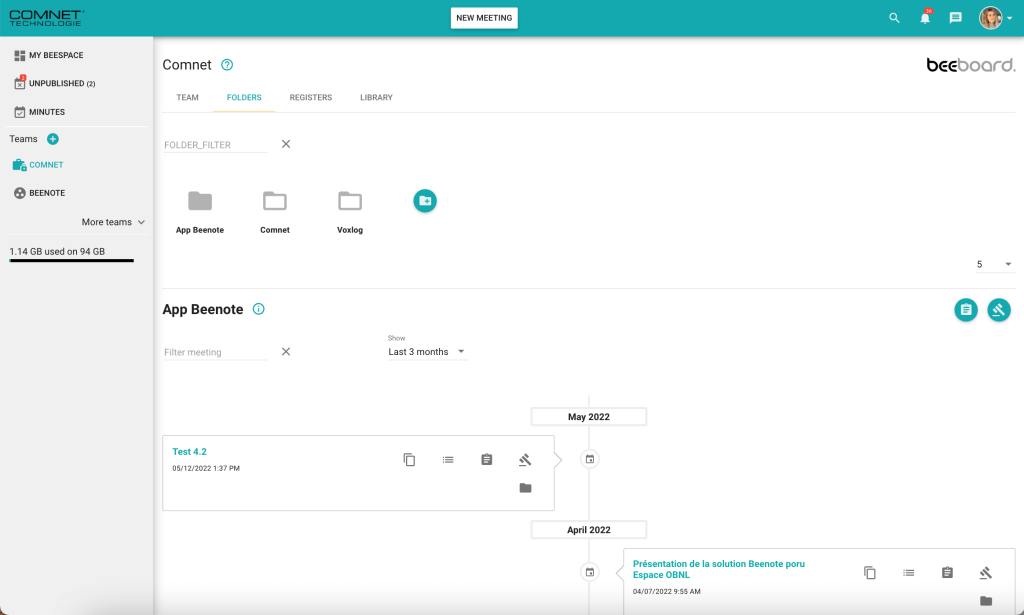
Some of our clients prefer to use one organization and then multiple teams for each of their departments. This is another best practice.
How does the meeting process work at Beenote?
Meetings at Beenote take place in 5 essential steps:
- Managing schedules
- Planning the agenda
- Running the meeting
- Writing the minutes
- Achieving the tasks
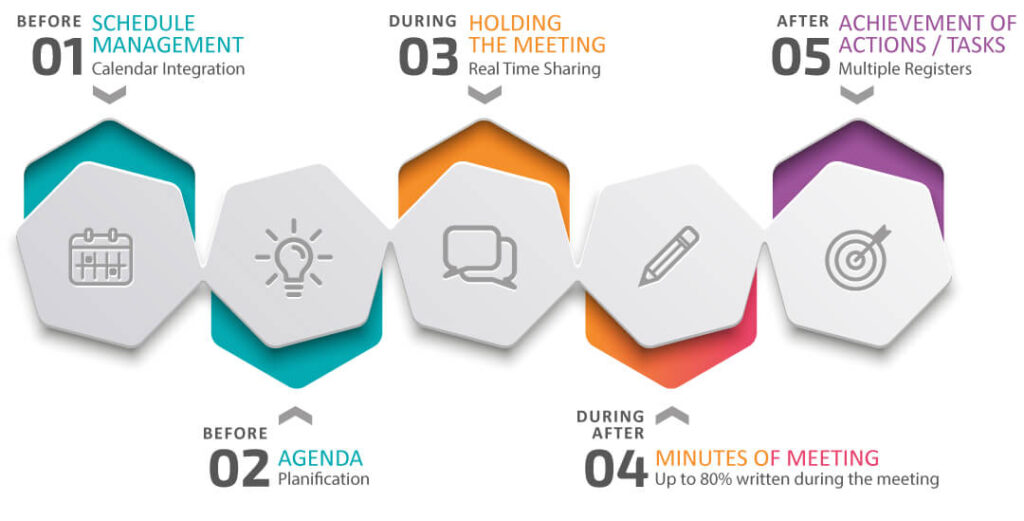
Schedule Management
At Beenote, we use Microsoft 365 integration (Google integration is also available) to schedule meetings.
Over time, we agreed that it would always be the same time slot to facilitate schedule management and make it easier for people to prepare in advance.
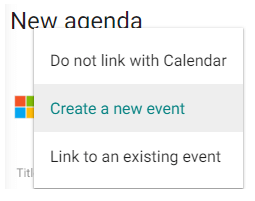
Pre-Work: The agenda
Send the invitation
The invitation, made by the leader, is made 3 days before the meeting to allow all participants to collaborate on the writing of the agenda. The role of the meeting leader is to take the initiative to create and take charge of the entire meeting process. Ideally, it changes at each meeting to allow each teammate to feel involved in the team and be active during the meeting.
As Beenote’s team is small, for us, 3 days are more than enough time for each partner to document the topic they consider relevant to share with everyone.
Complete the agenda
Beenote is a collaborative working tool. Each partner completes his topic on the agenda. He indicates, on this topic, the objective (inform, exchange, generate ideas, consult or decide), the person in charge (himself and the other people that it may be concerned, we even may invite a teammate for a specific topic only to attend), the relevant documents to be presented and that will be kept in the minutes’ registry as well as the estimated time for this topic.
When the partner finishes his topic, the overall meeting time is automatically adjusted in the calendar of all.
The agenda of the meeting also remains in draft form until the leader confirms it.

The meeting is ready to be held!
At the very end, with this agenda, we created a template that we use for future agendas.

D-Day: The 1st meeting with Beenote
Before we run the meeting
Before officially starting the meeting, it is important to determine the note taker. Ideally, he is not the leader of the meeting, because it is very difficult to do both tasks at the same time. We alternate this task from one meeting to the next by following a list of roles on the agenda at the end of each meeting.
At Beenote, we work remotely. We start the remote meeting with a video conferencing solution at the scheduled time on with our laptop or smartphone to follow the evolution of the agenda. Beenote is integrated directly into Teams to track the agenda and take notes in real-time.
The meeting link is entered into our Outlook calendar to start the meeting quickly.
We start the scheduled meeting
The leader makes sure that the agenda items are followed. He is the link between the various stakeholders and ensures that the time is respected. At each topic, a timer indicates when the time is up for the one speaking.
The note taker writes directly into Beenote everything that is relevant to add to each topic. He assigns tasks to the right people, and records and indicates the decisions that are taken. We use Antidote to correct the spelling in real-time.
All partners, meaning those who are responsible for a topic, can also add details to the notes.
Each participant takes his personal notes directly in Beenote. External guests use their own tools or a notebook and pencil for the more traditional ones.

At the end of the meeting, we determine the leader for the next meeting to be responsible for the entire process of the upcoming meeting.
To conclude: The minutes of meetings
The meeting leader (or one of the partners) is the one who completes the writing of the minutes and sends it to all participants as quickly as possible. Once the note-taking has been done during the meeting, he only needs to validate that everything is compliant.
If the notes were taken during the meeting, it is estimated that 80% of the work involved in writing the minutes was done.
Each participant receives an email notification that the minutes have been completed. It is added to the minute’s registry for future reference. Assigned tasks are also sent by email at the same time.
Holding the next meeting
As we still have the same template for holding our meetings, we duplicate the agenda of the previous meeting and each topic leader completes his part again.
The approval of the previous minutes is automatically added in Beeboard mode and manually in Beenote mode.
Tasks that have been assigned at meetings or in the minutes are automatically added to the agenda for the follow-up.
If there are tasks that have been assigned outside the meeting, we add them when the meeting is held with the task registry linked to the same file as the meeting.
Statistics for efficient meetings
For team leaders, managers, or anyone else in a management position, it can be very interesting to consult statistics on tasks, meetings, and meeting attendance.
“If we don’t measure, we can’t improve processes ” – Louis Turmel
Conclusion
Beenote is a meeting documentation tool, as it documents the entire process before, during, and after meetings, allowing you to search for topics, decisions, tasks, or minutes. In fact, any item that has been recorded in a meeting. We search by keywords in order to easily find what we are looking for.
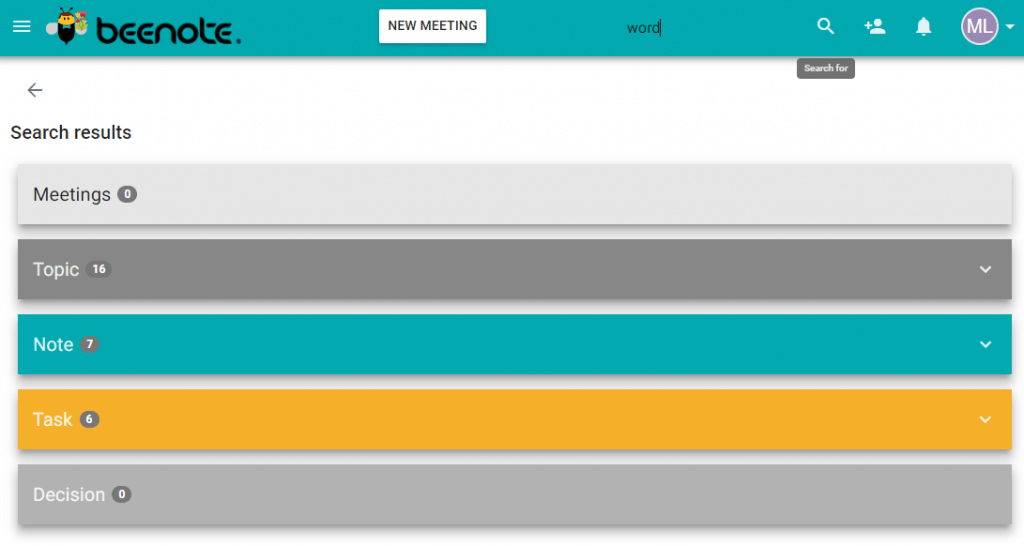
Beenote is a complete tool that greatly helps us to improve our process.
“We have improved our operational efficiency by 52%, the meetings are short, go straight to the point and we even enjoy attending them” – Mélanie Lessard, Marketing Director
Here is an African proverb to meditate on:
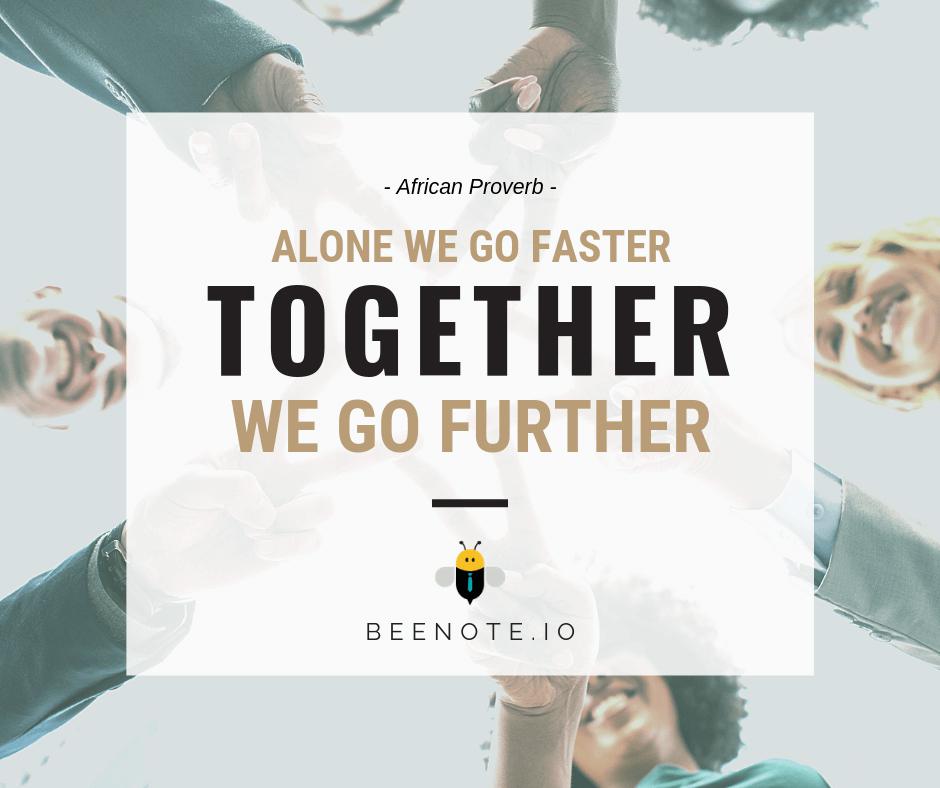






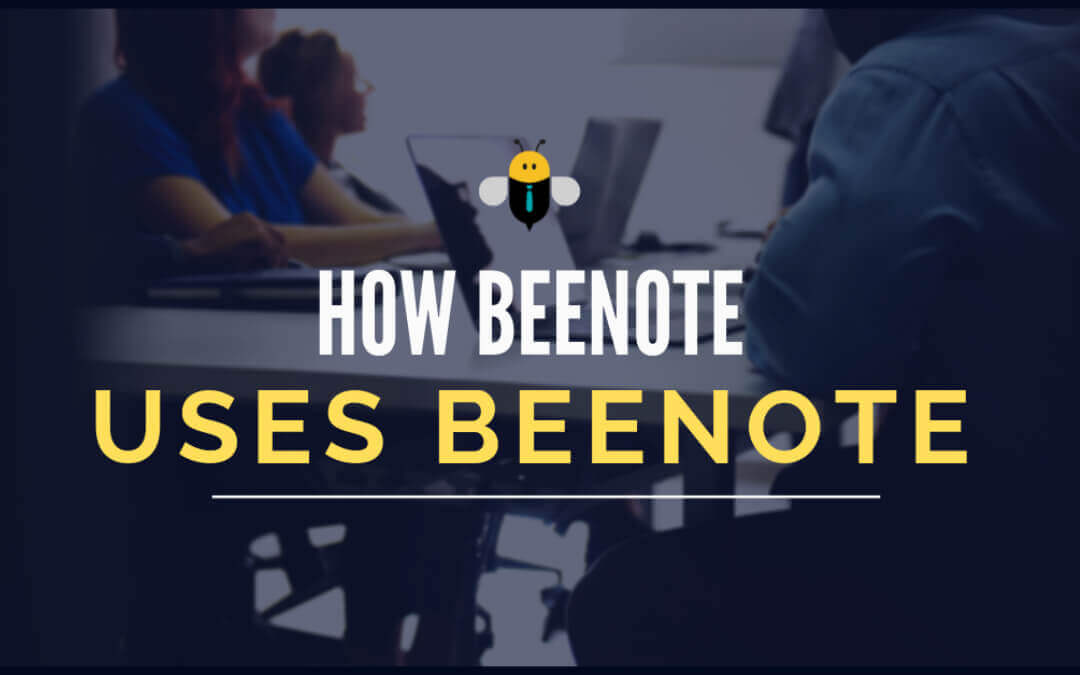



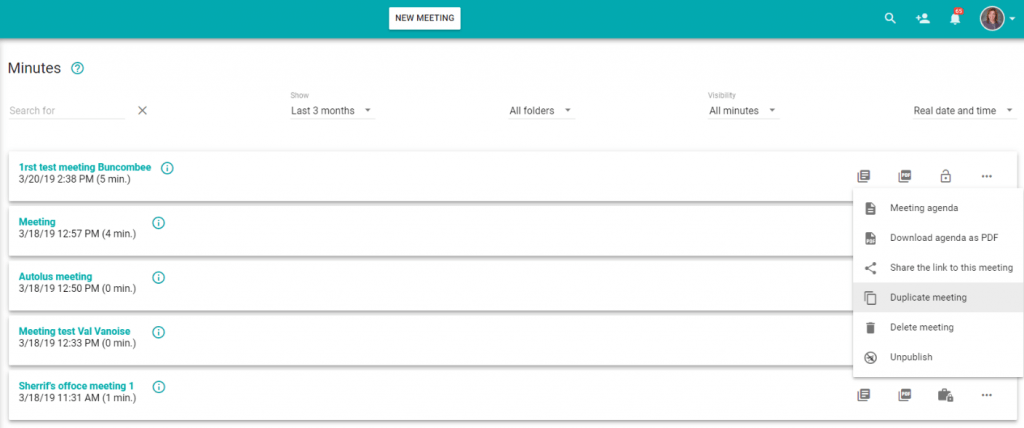
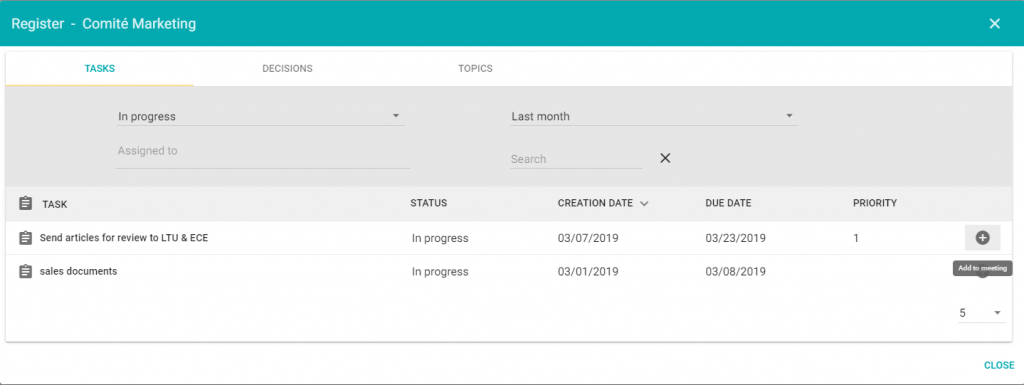

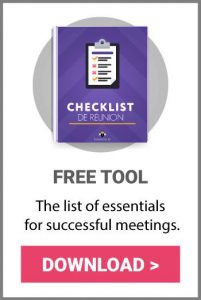
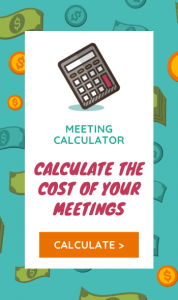
0 Comments